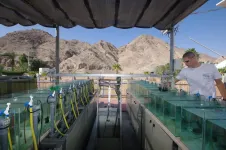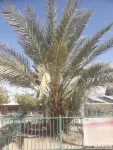Northern Red Sea corals pass heat stress test with flying colors
EPFL scientists are beginning to understand why corals in the Gulf of Aqaba, along with their symbiotic algae and bacteria, resist higher temperatures particularly well
2021-05-03
(Press-News.org) Even under the most optimistic scenarios, most of the coral reef ecosystems on our planet - whether in Australia, the Maldives or the Caribbean - will have disappeared or be in very bad shape by the end of this century. That's because global warming is pushing ocean temperatures above the limit that single-cell algae, which are corals' main allies, can withstand. These algae live inside coral tissue for protection and, in exchange, provide corals with essential nutrients produced through photosynthesis. Because the algae contain a variety of pigments and therefore give coral reefs their famous colors, if they are lost the corals turn white, which is known as coral bleaching. But in spite of the real threat caused by global warming, corals in the Red Sea look set to keep their vibrant color.
"We already knew that corals in the Gulf of Aqaba, at the northern tip of the Red Sea, were particularly resistant to higher temperatures. But we wanted to study the full molecular mechanism behind this resistance," says Romain Savary, a postdoc at EPFL's Laboratory for Biological Geochemistry (LGB) and lead author of the study, which appears today in PNAS. What the scientists found was telling: those corals, as well as the algae and bacteria they live in symbiosis with, can withstand average temperatures some 5°C higher than what they typically experience. And despite the severity with which climate change is taking place, it's unlikely that Red Sea temperatures will rise more than 5°C by the end of the century. "This gives us real hope that we can save at least one major coral reef ecosystem for future generations," says Anders Meibom, head of the LGB.
Taking it in stride
To conduct their study, the scientists subjected Gulf of Aqaba corals to a range of heat stresses including the higher temperatures likely to occur in the coming decades. The average maximum monthly temperature in these waters is currently around 27°C, so the scientists exposed coral samples to temperatures of 29.5°C, 32°C and 34.5°C, over both a short time period (three hours) and a longer one (one week). The scientists measured the corals' and symbiotic algae's gene expression both during and after the heat stress test, and determined the composition of the microbiome residing in the corals.
"The main thing we found is that these corals currently live in temperatures well below the maximum they can withstand with their molecular machinery, which means they're naturally shielded against the temperature increases that will probably occur over the next 100 or even 200 years," says Savary. "Our measurements showed that at temperatures of up to 32°C, the corals and their symbiotic organisms were able to molecularly recover and acclimate to both short-term and long-term heat stress without any major consequences." This offers genuine hope to scientists - although warmer waters are not the only threat facing this exceptional natural heritage.
This is the first time scientists have conducted a genetic analysis of coral samples on such a broad scale, and their findings reveal how these heat-resistant corals respond at the most fundamental level - gene expression. They can also be used as a basis for identifying 'super corals.' According to Meibom, "Romain's research gives us insight into the specific genetic factors that allow corals to survive. His study also indicates that an entire symphony of genetic expression is at work to give corals this extraordinary power." This sets a standard for what "super coral" gene expression looks like during a heat stress and a recovery. But could Red Sea corals be used to one day repopulate the Great Barrier Reef? "Corals are highly dependent on their surroundings," says Meibom. "They can adapt to new environments only after a long, natural colonization process. What's more, the Great Barrier Reef is the size of Italy - it would be impossible to repopulate it artificially."
Sailing towards the future
The scientists' work was made possible thanks to two unique research instruments: the Red Sea Simulator (RSS), developed by the Interuniversity Institute for Marine Sciences in Eilat, Israel; and the Coral Bleaching Automated Stress System (CBASS), developed by a team of researchers in the US. Their findings have laid the groundwork for a much more ambitious project that will be led by the Transnational Red Sea Center (TRSC, http://www.trsc.org), which was set up at EPFL in 2019. This new project will kick off this summer and take place over four years. "We'll sail the entire Red Sea - some 2,000 km long - on the research vessel Fleur de Passion, owned by our partner the Fondation Pacifique," says Meibom. "The goal will be to map the heat tolerance levels and the diversity of all the different types of corals found in these waters. Water temperatures rise as you head further south on the Red Sea, with a 5-6°C differential between the northern and southern tips. That's what makes it a perfect real-world laboratory for studying these ecosystems. It's as if you're sailing towards the future as you head south."
And what does that glimpse into the future tell us? Some corals in the southern Red Sea are already starting to bleach. Savary believes there's just one solution: "We have to protect these corals and shield them from local stressors, which are mainly sources of pollution and physical destruction. That way we can keep a stock of 'natural super corals' for potentially recolonizing areas that have been hit particularly hard by climate-change-induced heat waves."
INFORMATION:
[Attachments] See images for this press release:

ELSE PRESS RELEASES FROM THIS DATE:
2021-05-03
Abu Dhabi, UAE, May 3, 2021: Researchers from NYU Abu Dhabi's Center for Genomics and Systems Biology have successfully sequenced the genome of previously extinct date palm varieties that lived more than 2,000 years ago. They did so using date palm seeds that were recovered from archaeological sites in the southern Levant region and radiocarbon-dated from the 4th century BCE to the 2nd century CE. The seeds were germinated to yield viable, new plants. The researchers conducted whole genome sequencing of these germinated ancient samples and used this genome data to examine the genetics of these previously extinct Judean date palms. This study marks the first time researchers have sequenced the genomes of plants ...
2021-05-03
First-of-its-kind model replicates human alveolar lung tissue
Allows researchers to study effects of COVID-19 on cell growth and development
Provides insight as to how various drugs impact viral spread
Globally, lung failure is one of the leading causes of death. Many conditions can affect and damage the lungs, including asthma, chronic obstructive pulmonary disease, influenza, pneumonia, and, most recently, COVID-19. To better understand respiratory diseases and develop new drugs faster, investigators from Brigham and Women's Hospital designed a ...
2021-05-03
CHAMPAIGN, Ill. --A new study found overlooked tsunami hazards related to undersea, near-shore strike-slip faults, especially for coastal cities adjacent to faults that traverse inland bays. Several areas around the world may fall into this category, including the San Francisco Bay area, Izmit Bay in Turkey and the Gulf of Al-Aqaba in Egypt.
The study led by University of Illinois Urbana-Champaign civil and environmental engineering professor Ahmed Elbanna and professor Ares Rosakis of the California Institute of Technology used the Blue Waters supercomputer at the National Center for Supercomputing Applications to model ...
2021-05-03
ALBUQUERQUE, N.M. -- Sometime between 50,000 and 70,000 years ago, prehistoric humans took their first steps into Sahul, an ancient landmass made up of modern Australia, New Guinea and Tasmania. But nobody knows which way they went after that.
"One of the really big unanswered questions of prehistory is how Australia was populated in the distant past. Scholars have debated it for at least 150 years," said Sandia National Laboratories archaeologist and remote sensing scientist Devin White.
Now, an international team of scientists using a Sandia supercomputer in the largest reconstruction ...
2021-05-03
Palo Alto, CA--New work from a Stanford University-led team of researchers including Carnegie's Arthur Grossman and Tingting Xiang unravels a longstanding mystery about the relationship between form and function in the genetic material of a diverse group of algae called dinoflagellates.
Their findings, published in Nature Genetics, have implications for understanding genomic organizational principles of all organisms.
Dinoflagellates include more than 2,000 species of marine and freshwater plankton, many of which are photosynthetic, and some of which also ingest other organisms ...
2021-05-03
MADISON -- From radio to television to the internet, telecommunications transmissions are simply information carried on light waves and converted to electrical signals.
Silicon-based fiber optics are currently the best structures for high-speed, long distance transmissions, but graphene -- an all-carbon, ultra-thin and adaptable material -- could improve performance even more.
In a study published April 16 in ACS Photonics, University of Wisconsin-Madison researchers fabricated graphene into the smallest ribbon structures to date using a method that makes scaling-up simple. In tests with these tiny ribbons, ...
2021-05-03
SEATTLE--A new study of hospital deaths in the United States, published today in JAMA Network Open, is the most comprehensive look yet at changes in hospital mortality during the pandemic. Researchers analyzed data on more than 20,000 patients admitted to hospitals for COVID-19, over nine full months, from March to November of 2020. They found that rates of in-hospital mortality among COVID patients fell 38% between March and May, but there was little further decline through November 2020.
The researchers aimed to uncover the most likely cause of the ...
2021-05-03
People have become accustomed to having their temperature checked during the pandemic because fever is a key indicator of COVID-19.
A new commentary by Washington State University College of Nursing Associate Professor Catherine Van Son and Clinical Assistant Professor Deborah Eti proposes that taking a temperature is a less useful indicator of infection in older adults and that a pulse oximeter be used instead.
The paper, published in Frontiers in Medicine, said baseline temperatures are lower in older adults. A lower baseline temperature means a fever may ...
2021-05-03
Buildings - The mirage effect
A team of researchers at Oak Ridge National Laboratory has developed a method to detect and measure air leaking from a building's walls and roof that is quicker, cheaper and less disruptive to occupants.
Current air leak detection options, such as using a blower door and smoke or infrared thermography, are costly and invasive. ORNL's method is conducted from outside, using an imaging technique to visualize the flow of air leaks and calculate the volumetric flow of air based on the refraction effects imaged by cameras.
"Similar to a mirage over a black top road in the middle of summer, which looks fuzzy because ...
2021-05-03
BURLINGTON, VT -- In the aftermath of George Floyd's 2020 murder by former police officer Derek Chauvin, many families may find themselves actively engaging in--or uncomfortably fumbling around--discussions about race. For white parents looking to clearly communicate antiracist ideologies with their preadolescent children, a new study offers some insight.
"There's a difference between saying race "shouldn't" matter and race "doesn't" matter," explains Jamie Abaied, professor of developmental psychology at the University of Vermont and lead author of the study, ...
LAST 30 PRESS RELEASES:
[Press-News.org] Northern Red Sea corals pass heat stress test with flying colors
EPFL scientists are beginning to understand why corals in the Gulf of Aqaba, along with their symbiotic algae and bacteria, resist higher temperatures particularly well



